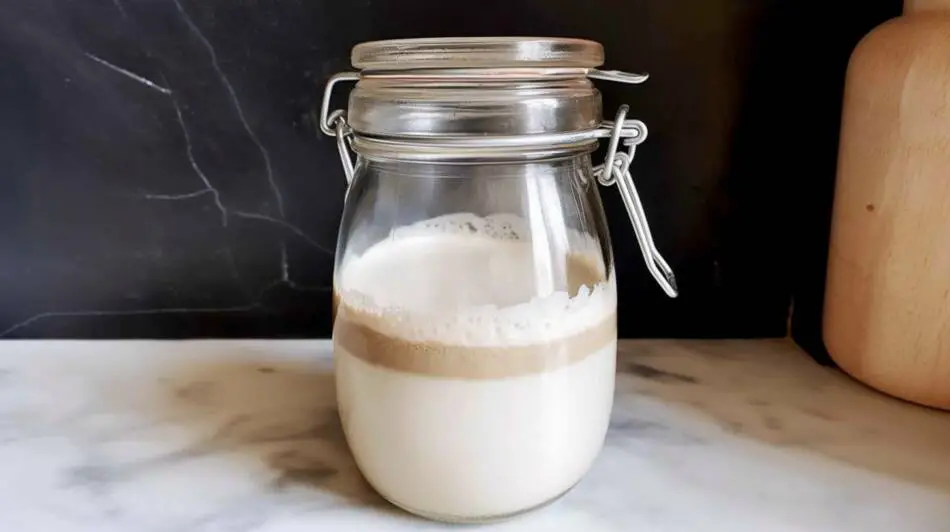If you’ve been cultivating a sourdough starter, you may have occasionally noticed a thin clear or slightly cloudy liquid on its surface. This liquid is commonly referred to as “hooch” in the sourdough community. While it might look concerning to the uninitiated, it’s a natural byproduct of the fermentation process. Let’s delve into what this liquid is, why it forms, and what you should do about it.
The clear liquid appearing atop your sourdough starter is termed “hooch,” resulting from fermentation’s alcoholic byproduct. While entirely harmless, you can choose to discard it or mix it back into the starter. Significantly, hooch’s presence often suggests that your starter is hungry and might benefit from more regular feedings.
1. What is ‘Hooch’?
Hooch is not just a random occurrence in your sourdough starter; it’s a deliberate result of microbial activity. Specifically, it’s a liquid layer that predominantly consists of water and alcohol. This distinct layer comes into being when the naturally occurring yeast and bacteria in your sourdough starter set about digesting the carbohydrates present in the flour.
During this fermentation process, two significant byproducts emerge: carbon dioxide, which is responsible for the bubbly appearance of a thriving starter, and alcohol. While the carbon dioxide gets trapped within the mixture, giving the starter its rise, the alcohol tends to pool on the surface, creating what we identify as ‘hooch’.
2. Why does the Hooch form?
a. Inconsistency in Feeding
One of the primary reasons for hooch formation is an inconsistent feeding schedule. When a starter isn’t fed timely or regularly, it tends to produce a more pronounced layer of hooch. This happens because, over time, the yeast and bacteria in the starter deplete the available food source. With no nutrients to feed on, they transition into a quasi-starvation mode, which prompts them to produce alcohol at an increased rate.
b. Ambient Temperature
The environment in which you store your starter plays a significant role in its fermentation rate. Starters that are housed in warmer surroundings experience expedited fermentation. If their feeding schedule isn’t adjusted to this accelerated pace, they are more prone to producing hooch.
c. Hydration Levels of the Starter
Not all starters are created equal. Their consistency, especially the ratio of water to flour, can greatly influence their behavior. Starters that are on the wetter side, known as high-hydration starters, have a predisposition to form hooch more regularly compared to their stiffer, low-hydration counterparts.
d. Choice of Flour

Every flour type brings its unique fingerprint to the table. While they all serve as food for the yeast and bacteria, their internal compositions can differ widely. Each variety, whether it’s whole wheat, rye, all-purpose, or another specialty flour, has its distinct carbohydrate profile. These varying profiles dictate how the resident microorganisms interact with them.
For instance, whole wheat or rye flour are teeming with complex carbohydrates that necessitate a longer breakdown process, thereby leading to a slow and steady fermentation. On the other hand, white flours and all purpose flour offer easily digestible compounds that can kickstart a rapid fermentation. This accelerated fermentation can sometimes expedite the production of alcohol, which, as we know, surfaces as hooch.
3. Is it a sign of a problem?
In most cases, it’s not necessarily a cause for alarm. The emergence of this liquid, known as hooch, stands as evidence that your starter is teeming with life and that the fermentation process is actively ongoing.
The yeast and bacteria within the starter are breaking down the flour’s carbohydrates and producing alcohol as a byproduct, which surfaces as hooch. But there’s another angle to it: consistent hooch formation may signify that the tiny organisms in the starter are craving more sustenance.
They might be indicating a nutritional deficit and voicing their hunger. Therefore, if you find yourself frequently greeted by this liquid layer, it’s wise to reconsider and possibly amend your feeding regimen.
4. What should you do about it?
If you see hooch on your starter, you have a few options:
a. Stir it Back In
For many, the sight of hooch isn’t a deterrent but an opportunity. By choosing to blend the hooch back into the starter during feeding, you’re not only reincorporating the moisture but also enhancing the sour profile of your starter. This richer, tangier nuance gets passed on to the bread, offering a pronounced sourdough flavor that many enthusiasts cherish.
b. Pour it Off
On the flip side, if your palate sways towards the subtler, milder notes of sourdough or if you’re met with an overly abundant layer of hooch, opting to drain it can be the way to go. By pouring it off, you ensure that the pronounced tang doesn’t overshadow the other delicate flavors and aromas in your sourdough creations.
5. How to Prevent Hooch from Forming
a. Regular Feedings
Ensure you’re feeding your starter consistently. If you’re seeing hooch frequently, you might need to feed your starter more often, especially if it’s kept at room temperature where fermentation occurs more quickly.
b. Maintain the Right Temperature

Cooler temperatures slow down fermentation. If you’re not baking daily or often, consider storing your starter in the refrigerator between feedings. This reduces the need for frequent feedings and slows down the formation of hooch. Remember to let it come to room temperature and feed it once or twice before using it in recipes.
c. Monitor Water-to-Flour Ratio
Maintaining a consistent hydration level in your starter can help. A thicker starter (lower hydration) is less likely to produce hooch than a very wet one. However, this can vary based on personal preference and the type of bread you’re baking.
d. Stir More Often
Even if you’re not feeding your starter, give it a stir once or twice a day. This helps integrate any forming alcohol back into the starter before it separates and becomes hooch.
e. Choose Your Flour Wisely
Different flours ferment at different rates. For example, whole grain flours tend to ferment faster than white flours. Being aware of this can help you adjust your feeding routine accordingly.
Conclusion
The appearance of hooch on your sourdough starter is a natural part of the fermentation process. It serves as a reminder of the lively microbial activity taking place within your jar. While it can indicate that it’s time for a feeding, it’s nothing to be alarmed about. Whether you choose to mix it back in or pour it off, it’s just one of the many fascinating facets of the art of sourdough baking.


